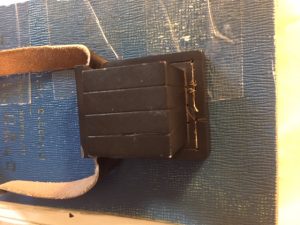Good tefillin gassot can last a lifetime, but typically they could use some refurbishing every 10 years or so. A customer who came to me for a tallis and tallis bag later told me he was considering the possibility of replacing his tefillin.
What would it cost for a new set of tefillin? I will send you picture of my current set.
I asked him to send a few pictures, including the top corners, the underside and the most worn part of the straps (typically the ends and near the knots). He did. They did look worn, but not abysmally worn.

Tefillin is not my area of expertise, but I put in my two cents anyway. “When the tefillin I bought before I got married were about 13 or 14 years old I had them refurbished,” I wrote to him. “That entailed opening them up, checking the parchments (which is typically done not by the tefillin maker but by a magihah), sewing them up again and replacing the straps. My tefillin were in better shape than yours are, from what I’m seeing. In my case it was definitely worthwhile; in your case, it’s a tough call to say whether they should be refurbished or replaced. Obviously it depends on the quality of the parchments and battim you have. So ideally you would take them to a tefillin macher for an expert opinion up close, which may even require opening them up just to decide. Where I live, there are probably two or three people within walking distance who provide this type of service. Where you live, I’m guessing that’s not the case. I don’t know how practical it would be for you to do that.

